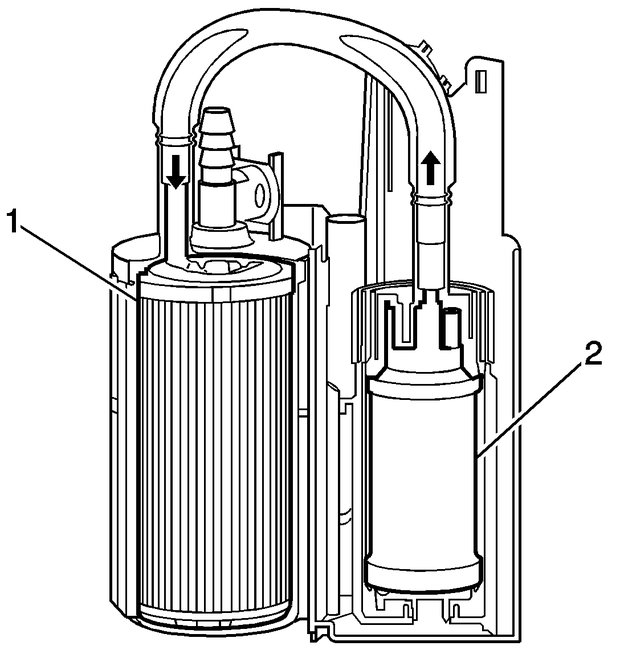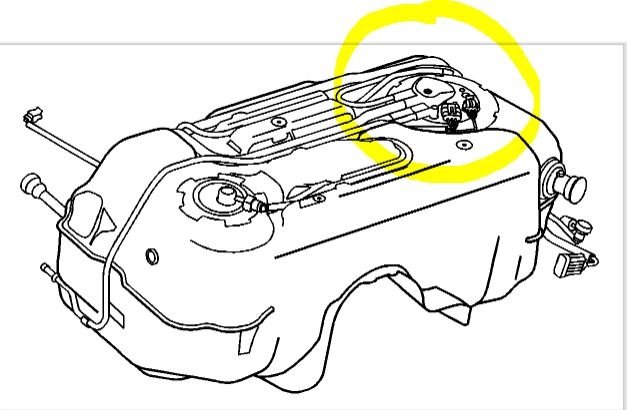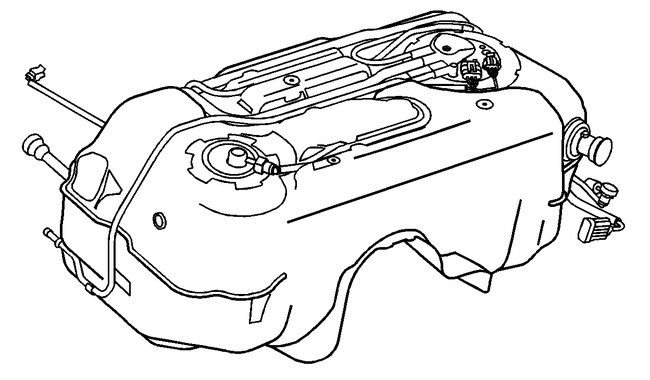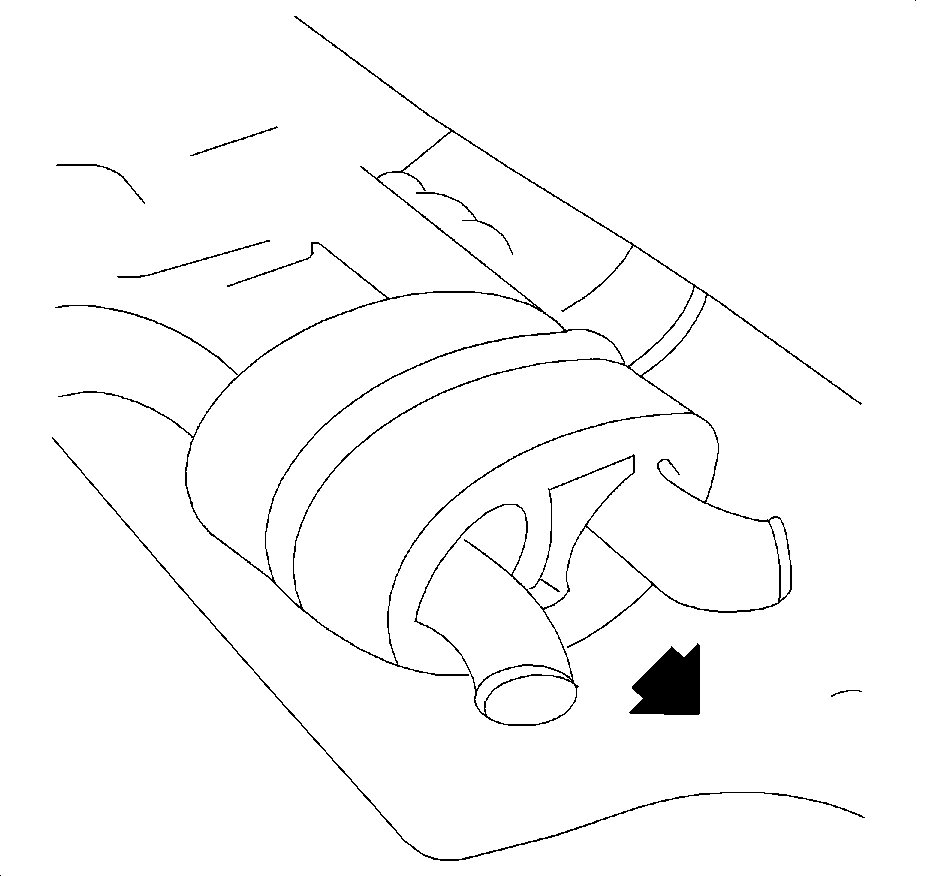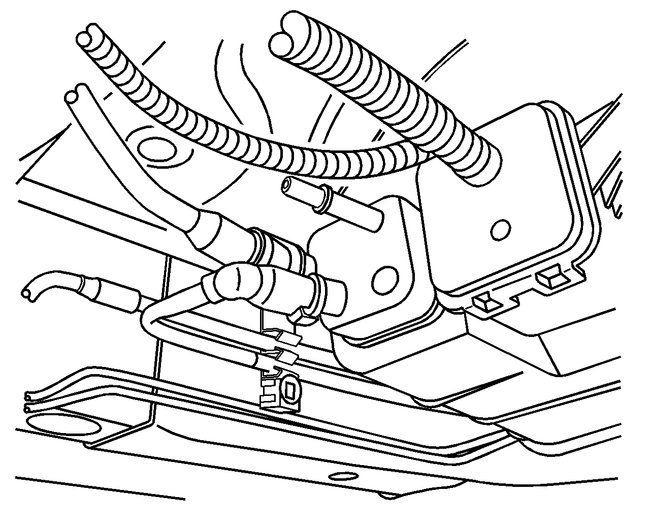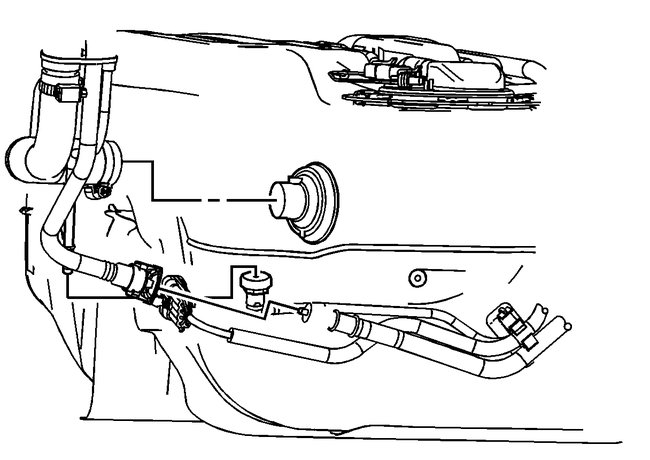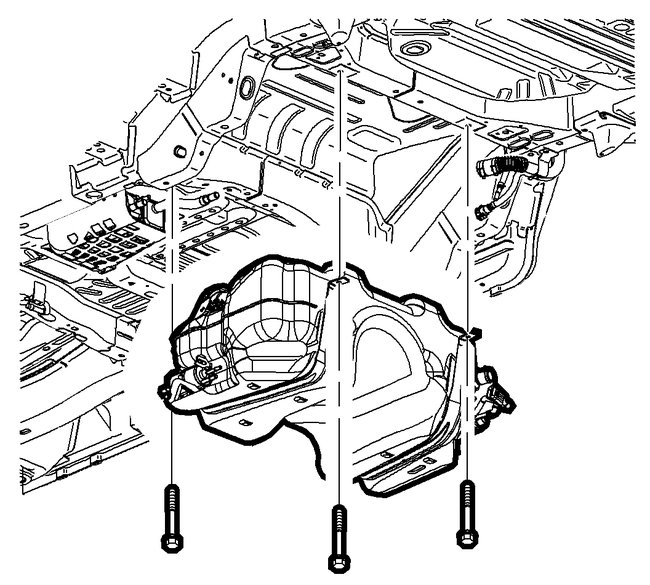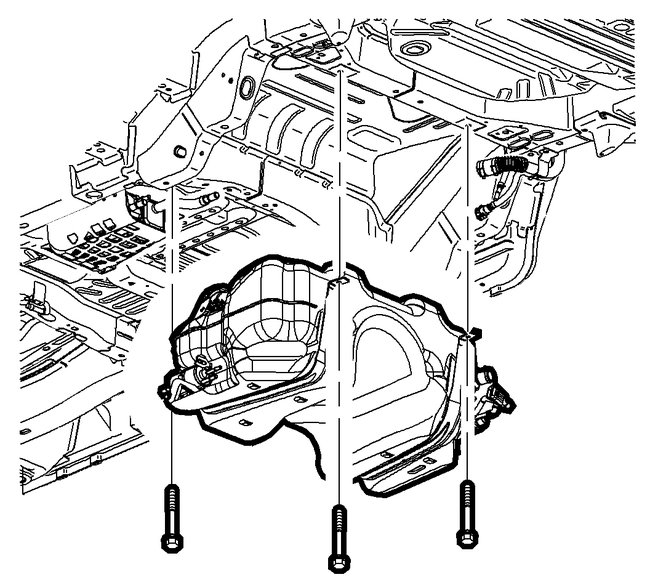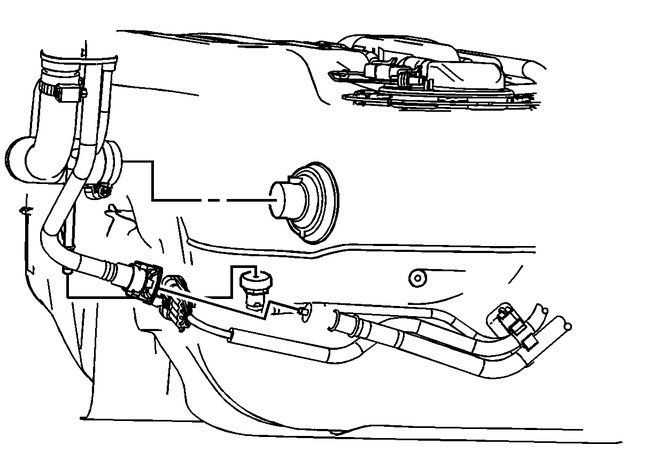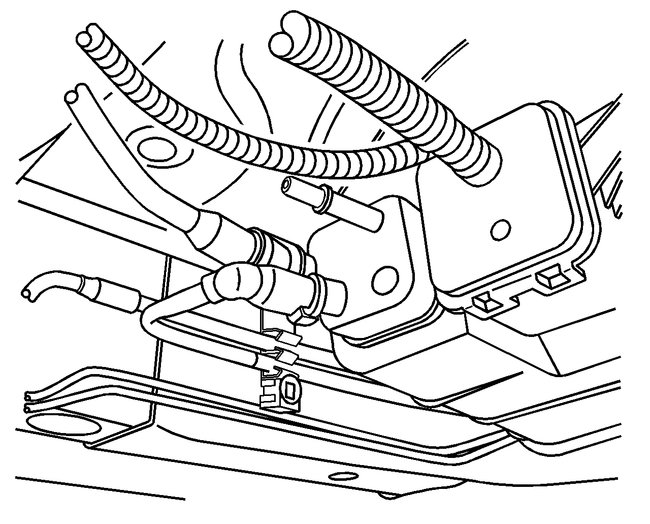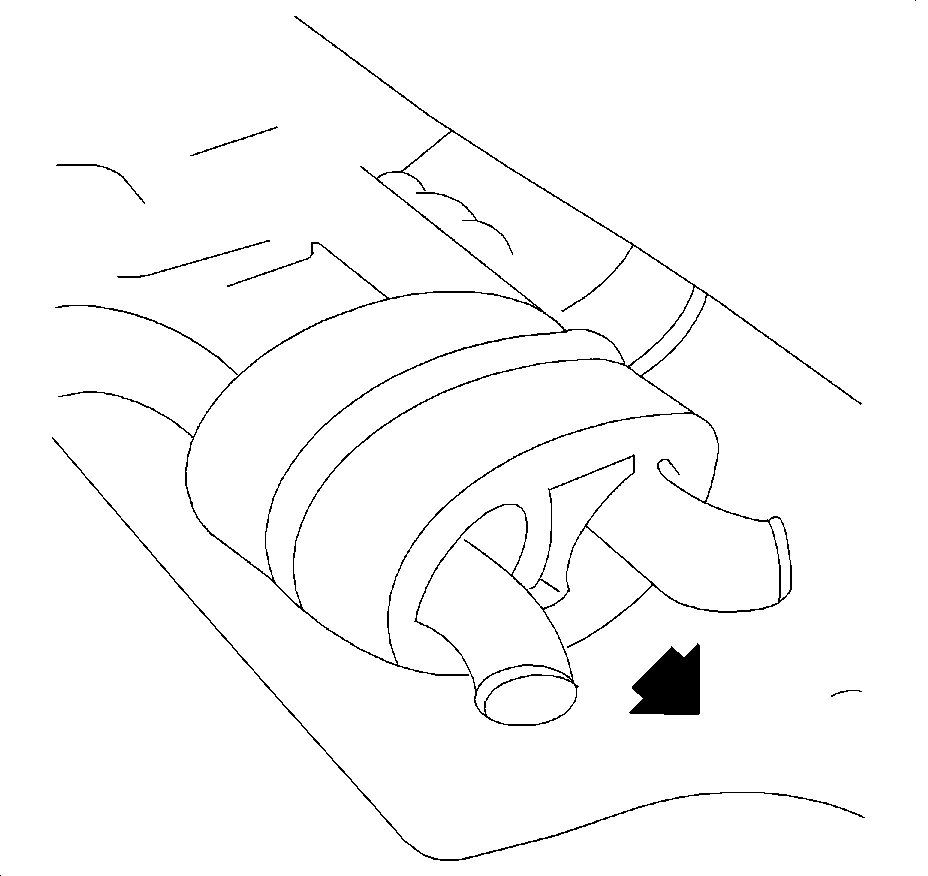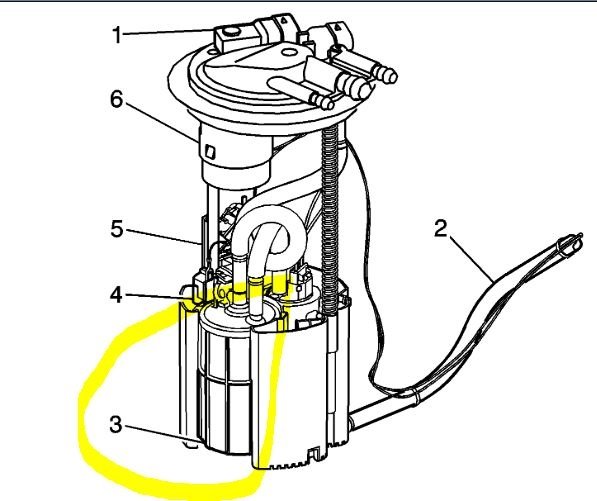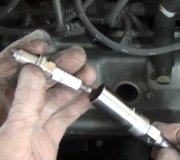Welcome to 2CarPros.
The fuel filter is located in the primary fuel tank module. Thus, the tank needs removed. See picture 1 for fuel filter picture.
Here are directions for removal of the primary fuel tank module. In picture 2, I circled the module needing removed.
FUEL TANK MODULE REPLACEMENT - PRIMARY
FUEL TANK MODULE REPLACEMENT - PRIMARY
TOOLS REQUIRED
J 45722 Fuel Tank Lock Ring Remover
REMOVAL PROCEDURE
1. Remove the fuel tank.
CAUTION: Whenever fuel line fittings are loosened or removed, wrap a shop cloth around the fitting and have an approved container available to collect any fuel.
NOTE: Clean all fuel pipe and hose connections and surrounding areas before disassembling to avoid possible contamination of the fuel system. Spray the fuel pump module cam-lock ring tang with penetrating oil prior to attempting removal.
2. Remove the secondary fuel pump module.
Pic 2
3. Disconnect the electrical connectors from the primary fuel pump module and fuel tank pressure sensor.
4. Use the J 45722 and remove the fuel pump module retaining ring.
NOTE: To prevent retainer damage, do not attempt to remove the retainer with a 12 in. Or shorter ratchet/breaker bar.
5. Disconnect the fuel feed and vent lines from the fuel tank.
6. Remove the primary fuel pump module assembly.
NOTE: To prevent bending of the sending unit float arm during removal, lift the pump module up slightly to disengage the orientation tabs in the tank and rotate the module 45 degrees.
7. Discard the fuel pump module-to-tank seal.
IMPORTANT: Always replace the fuel pump module-to-tank seal, O-ring, when the fuel pump module is removed.
8. If the fuel level sending unit is being replaced, remove the fuel level sender.
INSTALLATION PROCEDURE
pic 3
1. If the fuel level sending unit is being replaced, install the fuel level sending unit onto the new fuel pump.
2. Insert the new primary fuel pump module assembly with the level sender and the new fuel pump-to-tank seal. Ensure the orientation tabs are aligned.
3. Use the J 45722 to install the fuel pump lock ring.
4. Connect the wiring harness to the primary fuel pump module and fuel tank pressure sensor.
5. Install the secondary fuel pump module.
6. Install the fuel tank.
_____________________________________________________
Here are the directions for removing and replacing the fuel tank. The directions are for is a new tank is being installed, which isn't the case. But to get the directions, this is what I needed to add. The remaining pics correlate with these directions.
____________________________________________________
Fuel Tank Replacement
Vehicle Powertrain Management Fuel Delivery and Air Induction Fuel Tank Service and Repair Removal and Replacement Fuel Tank Replacement
FUEL TANK REPLACEMENT
FUEL TANK REPLACEMENT
REMOVAL PROCEDURE
1. Ensure that the fuel level in the tank is less than 1/4 full. If necessary, drain the fuel tank to at least this level. Refer to Fuel Tank Draining Procedure.
CAUTION: Do not allow smoking or the use of open flames in the area where work on the fuel or EVAP system is taking place. Anytime work is being done on the fuel system, disconnect the negative battery cable, except for those tests where battery voltage is required.
2. Relieve the fuel system pressure. Refer to Fuel Pressure Relief Procedure.
CAUTION: Fuel supply lines will remain pressurized for long periods of time after the engine is shutdown. This pressure must be relieved before servicing the fuel system.
3. Disconnect the negative battery cable.
4. Raise and support the vehicle. Refer to Vehicle Lifting.
Pic 4
5. Remove the rubber exhaust hangers on order to allow the exhaust system to drop slightly.
6. Remove the propeller shaft, if equipped.
Pic 5
7. Disconnect the evaporative emission (EVAP) canister vent and fresh air hoses:
1. Grasping both sides of the quick-connect fitting, twist the female connector 1/4 turn in each direction in order to loosen dirt within the quick-connect fitting.
2. Blow any dirt out of the quick-connect fitting using compressed air.
3. Squeeze the plastic retainer release tabs.
4. Pull the connection apart.
5. Inspect both ends of the quick-connect fitting for dirt and burrs.
NOTE: Clean all fuel pipe connections and surrounding areas before disconnecting the fuel pipes to avoid contamination of the fuel system.
Pic 6
8. Remove the fuel filler pipe, EVAP vent hose, and fresh air hose from the fuel tank.
9. Disconnect the chassis fuel supply line from the tank.
CAUTION: Whenever fuel lines are removed, catch fuel in an approved container. Container opening must be a minimum of 300 mm (12 in) diameter to adequately catch the fluid.
10. Disconnect the electrical connectors:
1. Fuel tank electrical connectors
2. EVAP solenoid electrical connector
pic 7
11. Support the fuel tank.
NOTE: Do not bend the fuel tank straps. Bending the fuel tank straps may cause damage to the straps.
IMPORTANT: Do not disassemble the rear drive module (RDM). It is not necessary to touch the RDM for fuel tank removal.
12. Remove the fuel tank strap bolts and fuel tank straps.
13. Lower the fuel tank from the underbody of the vehicle.
14. Remove the fuel tank module assemblies.
INSTALLATION PROCEDURE
1. Install the fuel tank module assemblies.
Pic 8
2. Install the fuel tank heat shield and fuel tank assembly into the vehicle.
3. Install the fuel tank straps and tighten the bolts.
NOTE: Refer to Fastener Notice in Service Precautions.
Tighten the fuel tank strap-to-body bolts to 25 N.M (18 lb ft).
Pic 9
4. Install the fuel filler pipe, EVAP vent, and fresh air hoses to the fuel tank.
5. Connect the electrical connectors:
1. Fuel tank electrical connector
2. EVAP solenoid electrical connectors
6. Tighten the hose clamp on the filler pipe-to-fuel tank connecting hose.
Tighten the fuel fill neck-to-fuel tank clamp to 5 N.M (44 lb in).
Pic 10
7. Connect the EVAP canister vent and fresh air hoses to the fuel tank hoses.
8. If equipped, install the propeller shaft.
Pic 11
9. Install the rubber exhaust hangers.
10. Lower the vehicle.
11. Fill the fuel tank with gasoline.
12. Connect the negative battery cable.
13. Prime the fuel system:
1. Cycle the ignition ON for 5 seconds and then OFF for 10 seconds.
2. Repeat the previous step twice.
3. Crank the engine until it starts. The maximum starter motor cranking time is 20 seconds.
4. If the engine does not start, repeat steps 13.1-13.3.
_______________________________________
If you look at the last picture, it shows the fuel pump removed. I circled the filter and yes, this is all attached to module 1. One last thing, I would also recommend replacing the fuel pump strainer at the same time the pump is out. The fuel strainer attaches to the lower end of the primary fuel tank module. The fuel strainer is made of woven plastic. The functions of the fuel strainer are to filter contaminants and to wick fuel. The fuel strainer normally requires no maintenance. Fuel stoppage at this point indicates that the fuel tank contains an abnormal amount of sediment or contamination.
Let me know if any of this helps or if you have other questions. As far as an inline filter, it doesn't exist or at least it didn't come from the manufacturer with one.
Take care,
Joe
Images (Click to make bigger)
Thursday, June 20th, 2019 AT 9:52 PM
